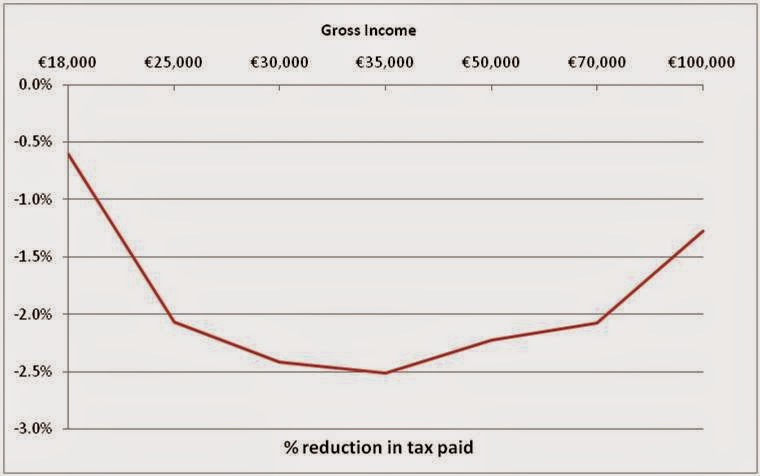TASC has developed a model to measure the effect of such changes on net incomes and effective tax rates (USC, PRSI and income tax) for a single person on any given gross income level. Here I use this model to show the impact of a reduction in the middle USC rate from 7% to 6% and assume all other rates and bands are left the same. We can then see who the winners are in this scenario.
Cash gained
Looking at the actual cash benefit to individuals (above), it’s clear that everyone earning above the minimum wage, working full time, will get an increase in their take home pay. By its very nature, those who earn more will gain the most in cash terms. Those just above the threshold of €17,576 will get very little (someone with an annual income of €18,000 will gain €4 per year), those at the top of the threshold (€70,000) and above will gain upwards of €500 per year.
While the benefit is ‘capped’ (because we assume there is still an 8% USC on incomes above €70,000), everyone above the threshold of €70,000 will still receive a benefit from the reductions to the earlier part of their income.
Reduction in tax paid
Another way of looking at it is to ask: who got the biggest tax cut as a percentage of the tax they currently pay? If this is the question, then the picture favours those at around €35,000, who would get a cut of about 2.5% in their current total annual tax/USC/PRSI. Those above and below this figure get less of a tax cut as a proportion of their current contribution.
Change in income
A third way of looking at it is to see what the percentage change in a person’s take-home pay (net income). We see that again the major benefit goes to those near the upper end of the threshold (€70,000). However because the actual amount given back to the individual stays the same above this threshold, the percentage change in income declines for those on higher incomes.
Conclusion
While a change such as this will be marketed as a move to help those on "low and middle incomes", we see that the real impact will be for those on higher incomes:- Those on €70,000 - the entry point for the top 10% of earners - benefit most both absolutely (with the greatest cash benefit) and proportionately (the greatest percentage increase in net income). While those on higher incomes see the proportional benefit go down, they nevertheless do still get a cash benefit that is greater than for people on lower incomes.
- Those on €35,000 see the greatest benefit in terms of the percentage reduction in their tax contribution, but not in terms of the actual amount they gain in cash, or the percentage increase of their take home pay.
- Those below €35,000, who are the real low-to-middle earners, benefit the least in both absolute and proportionate terms.
And there is zero benefit to those earning less than this. In the last Budget, Revenue estimated that such a cut would cost €368 million which could be used to invest in public services that would ultimately benefit all of society.
Cormac Staunton is Policy Analyst at TASC. You can follow him on Twitter @Cormac_Staunton




No comments:
Post a Comment